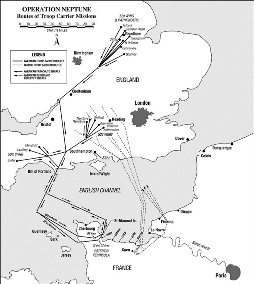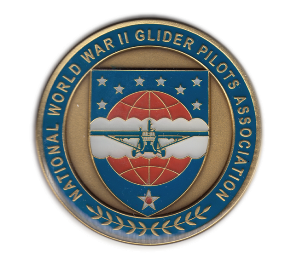National WWII Glider Pilots AssociationLegacy Organization of veterans National WWII Glider Pilots Association. | ||
| Mission Date | Serial | TC Group | subMission | Air Field | # CG-4A | # Horsa | Inf. Div. | Load | Landing Zone |
|---|---|---|---|---|---|---|---|---|---|
| Mission Date | Serial | TC Group | subMission | Air Field | # CG-4A | # Horsa | Inf. Div. | Load | Landing Zone |
| 1944-06-06 | 27 | 434 | Chicago | 467-Aldermaston | 52 | 0 | 101 | 155 men: 2 Btys 81st AA Bn, Engineers Elmts 327th GIR (anti-tank plat. Hq Co.) Signal 1 surgical unit Staff pers. 1 Bulldozer 16 x 57mm guns 25 vehicles | E |
| Chicago Serial --
Details---Mission | |||||||||
| 1944-06-06 | 28 | 437 | Detroit | 469-Ramsbury | 52 | 0 | 82 | Btry A & B 80th Abn AA Bn Hq 82nd Abn Div 82nd Abn Div Arty 82nd A/B Sign Co | O |
| 1944-06-06 | 29 | 434 | Keokuk | 467-Aldermaston | 0 | 32 | 101 | 157 men: Signal Medical & Staff pers. 40 vehicles 6 guns 19 tons of equipment and supplies | E |
| Keokuk Serial (Neptune) 11 C-47’s towed 11 Horsa to LZ on Cherbourg Peninsula. All gliders hit landing area and all power crews returned without a casualty. Major Hansley flew as Group Deputy Commander and the 72nd Lead the Group. Summary of Keokuk Mission | |||||||||
| 1944-06-06 | 30 | 437 | Elmira | 469-Ramsbury | 8 | 18 | 82 | Btry C 80th Abn AA Bn Hq 80th Abn AA Bn 82nd Abn Div Arty 82nd A/B Signal Co | W |
| 1944-06-06 | 31 | 438 | Elmira | 486-Greenham Common | 14 | 38 | 82 | 82nd Abn Recn Platoon 82nd Signal Co Hq 82nd Abn Div 307th ABn Medic Co | W |
| 1944-06-06 | 32 | 436 | Elmira | 466-Membury | 2 | 48 | 82 | 319th GFA Bn 320th GFA Bn 307th Abn Medic Co Co A 307th Abn Engr Bn 82nd Abn Div Arty | W |
| 1944-06-06 | 33 | 435 | Elmira | 474-Welford | 12 | 38 | 82 | 320th GFA Bn | W |
| 78th TC Squadron, 435th TC Group Report | |||||||||
| 1944-06-07 | 34 | 437 | Galveston | 469-Ramsbury | 32 | 17 | 82 | 1/325th GIR Co A 307th A/B Engr Bn | W |
| All Planes in this First Serial were flying at very low altitudes, due to bad weather when starting out. Altitudes ranged between 100 to 200 feet and at these heights the gliders could glide only half a mile or remain in the airborne more than 30 seconds. All but six of the gliders released too soon and landed between the two southern causeways leading inland from Utah Beach toward LZ E. The gliders landing east of LZ E encountered minor sniper fire, but suffered numerous landing accidents. Nine WACOs and 10 Horsas were destroyed, while 22 gliders were damaged. Personnel losses were heavy. Seventeen troops were killed and 85 more were injured. -World War II Glider Pilots pg24 | |||||||||
| 1944-06-07 | 35 | 434 | Galveston | 467-Aldermaston | 50 | 0 | 82 | Hq & Hq Co 325th GIR Co A 307th Abn Engr Bn 82nd Abn Recn Plat 82nd Abn Div Arty Cmd Veh 508 Prcht Inf | W |
| 74TH TROOP CARRIER SQUADRON: Fifty C-47s and fifty CG-4As took off from Aldermaston at 0432 on 7 June for LZ on Cherbourg peninsula near previous LZ. They carried 251 personnel, 24 jeeps, 11 guns and 10,370 pounds of ammunition in addition to other supplies. Forty-eight gliders were released at the LZ. One lost an aileron, cutting loose and landed successfully at "Flatbush" (near coast of England). One landed at (37.2 - 95.8) a little north of LZ W. There were no navigational aids or markers at the LZ but gliders made successful landings. Small arms fire was intense and many planes received small damage from bullet holes. One Radio operation in the 74th TC Squadron was wounded in the leg. 72nd Major Hensley lead the 72nd squadron which flew third spot in the group formation. This was his second mission into Normandy. USAFHRA 434th Troop Carrier Group Summary of Operational Missions Summary of Galveston Mission | |||||||||
| 1944-06-07 | 36 | 439 | Hackensack | 462-Upottery | 20 | 30 | 82 | 2/325th GIR 2/401st GIR | W |
| 1944-06-07 | 37 | 441 | Hackensack | 464-Merryfield | 50 | 0 | 82 | Hq 2/325th GIR Hq 2/401st GIR Serv Co 325th GIR Cmd Veh 505, 507 & 508 Prcht Inf | W |
| 100th TROOP CARRIER SQUADRON: At 0715 hours, June 7, twelve planes took off towing twelve GC-4A Gliders on a glider airborne mission. Once in the air the aircraft found that they were to have good fighter cover: P38s, P46s, and P51s escorted them. The aircraft arrived over the GLZ (glider landing zone) at 1900 hours. The GLZ was located one mile due South of Ste. Mère-Église. There was no enemy air opposition encountered. However, over the Cherbourg Peninsula and drop zone small arms fire was constant. The twelve gliders were released, and it was observed that they descended in an excellent landing pattern, and in an area that did not appear to be saturated with craft previously landed. They were dropped at an altitude of 700 ft. The twelve gliders were expended with one glider pilot being killed in a crash landing, and two other glider pilots wounded: F/O Hubert W. Lindsey was Killed in action in glider no 43-19874, F/O Drew C Walker sustained fractures of both legs (flying glider no 43-19874, as Co-pilot), and F/O Ralph J Kester, although no confirming data on him has been available, was reported on June 9th to be still in France with a broken right ankle. The mission was successful, the tug planes circled, dropped the nylon ropes, and made a 180 degree turn with the express purpose of executing that military move strategically known as "getting the Hell out!!" The gliders came down with all cargo usable, and all airborne personnel were delivered without loss. (though many of them were doubtless shaken up a bit, for many of the gliders were forced to semi-crash land by the unexpectedly tall hedges, and surprisingly small fields in which to stop.) The total cargo weight (including airborne men) ferried by the gliders amounted to 45,535 lbs. The equipment carried was principally ammunition, 1/4 ton trailers, five gallon water cans, and 81 mm CL HE. 100th historical narrative, Capt. Joseph C. C. Paradis, Air Corps, Intelligence Officer. 99TH TROOP CARRIER SQUADRON Five Officers and Nineteen Flight officers on detached service with the 82nd Airborne Division in Cherbourg Peninsula. AIR ACTIVITY: Thirteen planes and twelve gliders loaded with special supplies and equipment's took off for Cherbourg peninsula. Returning planes reported only sporadic small arms fire and very good excellent fighter coverage for our transports. All gliders reported cut loose at proper Landing Zone. Lead ship, not towing glider, was flown by Lt. Col T. G. Kershaw, Commanding Officer of the 441st Troop Carrier Group who used our plane as lead plane for entire Group Operation. In preparation for Hackensack 12 Glider Pilots were briefed in advance as to what to expect and what to look for. Escape kits and purses were handed out as usual. The Glider Pilots and their Co-pilots wore field equipment and were prepared for any eventuality that might befall ground troops as they landed with their airborne passengers and must be prepared to defend themselves or in any way aid the troops. Photo interpretation had shown the Glider Pilots pictures of fields they were to land in but had erred in interpreting the natural fence around the fields. What were thought to be high hedges, turned out to be tall trees, which had been clipped, and many fields were found to be studded with strong poles, making landing in them almost impossible. However, with a great deal of luck and skill all our gliders were crash landed with a minimum damage to their precious cargoes of men and supplies. Although the landing was "rough", none of the pilots were injured and almost all of them were able to lend a helping hand to the ground troops in the unloading of the gliders and then some of the pilots even volunteered to stay and help as ammunition bearers in order to help during the crucial hours. 99th historical Diary June 7, 1944 | |||||||||
Special thanks to Patrick Elie’s work at D-Day : Etat des Lieux
NORMANDY
11 Serials - 514 gliders
ACCOUNTS
Flight serials and formation
Courtesy– D-Day : Etat des Lieuux
et Patrick Elie
et Patrick Elie
Summary of Operational Missions:
6 June 1944 - Chicago Serial 27
Preparing for the Elmira Mission, Greenham Common.
f000279 Angleterre / Normandie.
Into the Valley (pg.112) Col. Charles H. Young
Neptune Operation air assault route from England.
Neptune Operation air assault route from England.
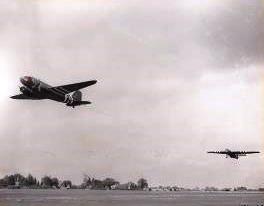
Courtesy of the National Archives /Hans den Brok collection
A C-47 and Horsa combination takes off from Greenham Common as part of the Elmira mission. The C-47 pictured here would later crash on a glider mission to Holland.
A C-47 and Horsa combination takes off from Greenham Common as part of the Elmira mission. The C-47 pictured here would later crash on a glider mission to Holland.
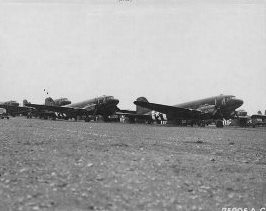
Courtesy of the National Archives / Hans den Brok Collection<
Tow planes and gliders of the 439th Troop Carrier Group are lines up on the runway before the Hackensack mission.
Tow planes and gliders of the 439th Troop Carrier Group are lines up on the runway before the Hackensack mission.
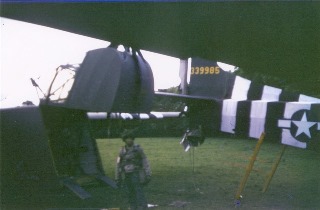
S. Robert Winer/ Hans den Brok collection
Two gliders of the very first mission in the Normandy fields.
Two gliders of the very first mission in the Normandy fields.

